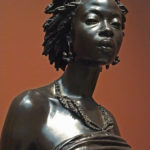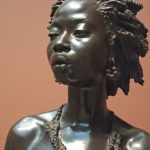1800s Week!
Charles Cordier
African Venus
France (1851)
Bronze, 39.5 cm.
Cordier submitted a plaster cast of the bust of an African visitor to Paris to the Salon of 1848, and two years later he again entered it as a bronze (Walters 54.2664). A young African woman served as the model for this companion piece in 1851. Regarded as powerful expressions of nobility and dignity, these sculptures proved to be highly popular: casts were acquired by the Museum of National History in Paris and also by Queen Victoria. The Walters’ pair were cast by the Paris foundry Eck and Durand in 1852. These bronzes were esteemed by 19th-century viewers as expressions of human pride and dignity in the face of grave injustice.
[mod note]
One of the things I love most about this piece is that you get something new from almost every single angle.
Photo credits: galeri.uludagsozluk.com, opacity (flickr), The Walters Museum.
It is stunning, I wonder who the woman was, where she was from, what did she think of the world?
I’ve learned since that the woman who posed for this amazing work was named Seïd Enkess. She was a Frenchwoman originally from southern Sudan, who had been enslaved as a child, but worked as model in Paris as an adult.
A superb Sudanese appeared in the studio. Within a fortnight, I made this bust. With a comrade, I carried it into my room, by my bed […] I coveted the artwork […] I had it cast and sent it to the Salon […]. It was a revelation for the whole artistic world. […] My genre had the novelty of a new subject, the revolt against slavery, anthropology at its birth…

Just another WordPress site




